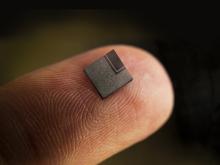Insights
|
08 Apr 2022
Thread vs Bluetooth: Which is best for smart homes and buildings?
To be truly smart, smart building solutions need to leverage the strengths of the most adapted wireless technologies.

There are a million reasons why smart home technology is on the rise. Imagine entering your home, walking through hall to your kitchen, opening the fridge, and pouring yourself a glass of milk. After being identified by your connected domestic alarm system and let in by your smart lock, an occupancy monitor might adjust the blinds, control the lighting, and set the air conditioning to your liking, as your smart fridge senses the amount of milk consumed and, if necessary, adds a note to stock up on more on your smartphone app.
All that before you even ask your voice assistant to play you a podcast...
As connected alarm panels, locks, lighting, heating, and ventilation systems move from the margins to the mainstream, efforts are underway to align the wireless communication technologies, protocols, and standards they depend on to promote interoperability across manufacturers, simplifying adoption. Among the panoply of technologies tossed around when discussing smart homes are Bluetooth® low energy and Thread.
Bluetooth low energy and Thread are both short range communication technologies. As such, they need a local gateway to access the internet. So, if Bluetooth low energy and Thread serve a similar purpose, which of the two should smart home solution developers manufacturing devices and end users shopping for them for their homes opt for?
In this blog, we shed some light on what the two technologies have in common, what sets them apart, and how they can complement each other in smart home deployments.
Bluetooth low energy and Bluetooth mesh
When it comes to name recognition, Bluetooth clearly comes out on top. Designed into the majority of connected devices sold today, Bluetooth low energy offers a low-power communication channel to connect sensors, switches, and appliances to smartphones or, via a gateway, to the internet. Bluetooth low energy communicates on the 2.4 GHz spectrum, achieving bit rates of 125 to 2000 kilobits per second, and is primarily used for data transfer. Bluetooth low energy achieves a point-to-point range of up to around 50 meters beyond line of sight in common indoor environments.
Particularly relevant to smart building deployments is Bluetooth mesh. True to its name, Bluetooth mesh can connect a vast number of smart home sensors, appliances, lights, and other devices into a mesh network, in which messages are relayed from one node to the next until they reach their final destination.
Bluetooth mesh networks transfer messages across the network using a lightweight, flood-based approach, pushing messages to all nearby nodes. This increases the simplicity, reliability, and scalability of the achievable networks, and ensures that messages reach their destination even if individual nodes are offline.
Bluetooth mesh networks are made up any number of low-power nodes such as sensors, friend nodes that support low-power nodes, and powered relay nodes that receive and transmit messages, and proxy nodes, that link Bluetooth low energy devices with the Bluetooth mesh.
Bluetooth low energy offers four levels of security to protect point-to-point links: no security, unauthenticated paired link, authenticated paired link, and LE Secure Connections, the highest security level. Bluetooth mesh, meanwhile, uses three layers of security keys, leveraging a unique device key, an application key, and a network key.
Thread (802.15.4)
Thread, on the other hand, is hardly a household name. Neither is IEEE 802.15.4, its underlying radio protocol. Like Bluetooth LE, Thread is a low power technology that communicates on the 2.4 GHz spectrum. Designed for mesh networking, it makes more sense, however, to compare Thread to Bluetooth mesh.
Thread’s arguably most important differentiator is that it is based on the internet protocol (IP). As a result, it offers native IPv6 support, making it particularly simple to build solutions that interact seamlessly with devices from other manufacturers. It’s also a key reason why the Matter smart home connectivity standard launched by the Connectivity Standards Alliance has selected Thread over Bluetooth LE to carry communications between devices.
Whereas Bluetooth mesh uses message flooding to transfer messages across the network, Thread uses a routed approach, in which messages can hop from device to device along predefined routes until they reach their intended destination. If individual nodes along their route are temporarily down, the network automatically redirects messages via an alternative route to increase resilience.
Thread mesh networks are made up of three different classes of devices, with a maximum of 16352 nodes per network. End devices, typically sensors or switches, simply transmit and receive data. Routers, of which there can be up to 32 in a network, are nodes that receive messages, amplify them, and retransmit them. And border routers are basically gateways between the smart home network and the broader internet.
Another reason why the Matter standard selected Thread is the maturity of the border routers, both in terms of their specification and reference implementations. Because they support NAT64 and DNS64, which facilitate the transition from IPv4 to IPv6 protocols, they can already be used in real-world deployments today.
Thread secures communications using a master key to encrypt and protect all data traffic. To join the Thread network, joiner nodes are required to authenticate themselves to the thread leader using a DTLS session with PKI- (public key infrastructure) or PSK- (pre-shared key) based keys.
Commonalities and differences
Thread and Bluetooth are comparable on many fronts. Both offer short-range wireless communication on the 2.4 GHz band. Both can be used to set up mesh networks, with all the benefits that come with this topology, including extended range and enhanced robustness. And both are roughly on par when it comes to current consumption.
The technologies do, however, differ in some crucial, other more subtle areas. Key among them is that Thread communicates using the internet protocol (IP). At the cost of an increase in data overhead, this makes it straightforward for solution developers to manage Thread-based communication the same way that they would design any other form of wired or wireless internet communication.
Bluetooth, meanwhile, supports the deployment of much larger networks. With its vast ecosystem and ubiquity in the field, Bluetooth offers a natural communication channel between smart home devices and smartphones. Additionally, the fact that Bluetooth devices do not run over IP brings its own set of advantages. Non-IP based devices are less exposed to security risks than devices that are connected to the internet. As a result, they can be protected using lighter security protocols and a reduced security overhead.
When to use what
Bluetooth mesh is already established in smart lighting solutions used in commercial and industrial buildings. Thread, on the other hand, has the potential to grow its footprint in smart home use cases, thanks to its inclusion in the Matter standard. Backed by some of the biggest names in the industry, including Apple, Google, Samsung, Ikea, Schneider Electric, and many more, Thread could well be used to connected smart devices in households even before the technology itself becomes a household name.
Ultimately, the most optimal technology for a specific deployment will depend on use case at hand, and on specific interoperability requirements. Industrial use cases could well continue to favor Bluetooth low energy and Bluetooth mesh. And with the Matter standard gaining clout in the industry, Thread is a strong contender for device-to-device connectivity in smart homes and connected buildings.
Meanwhile, as per the Matter standard, Bluetooth LE will be the communication channel of choice to connect to smart home devices for commissioning and configuration, taking advantage of its ubiquity in today’s smartphones and tablets.
Learn more about our Bluetooth low energy, Bluetooth mesh, and Thread portfolio on our website. And be sure to reach out to your nearest sales representative for an in-depth discussion on how u-blox can help you solve the smart home and connected building challenges your business is facing.
Stefan Berggren
Senior Product Marketing Manager, Product Strategy Short Range Radio


